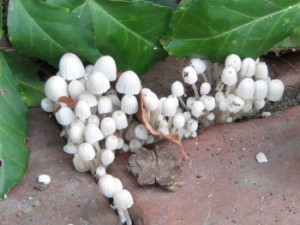Would you pay more for an apple if it was produced with fewer chemicals? Probably not if it’s ugly, according to a paper by Chengyan Yue, Helen H. Jensen and others at Iowa State University. But maybe you’d reconsider if you knew that ugly apples can taste great. Take this apple, for instance.

From the side

From the bottom
That ugly apple came from my gigantic haul from the Lawrence Farmers Market recently, and I’m here to tell you it was delicious: crisp, juicy, flavorful. I, an apple culture ignoramus with access to the World Wide Web, have diagnosed it and its fellows as a victim of sooty blot and flyspeck fungi, as illustrated here and at Ohio State University Extension. Accordingto Iowa State Extension, “Sooty blotch and flyspeck fungi harm only the appearance of an apple, not its taste.” Indeed.
Sure, pretty is appealing. But when you get fresh, tree-ripened local apples with a little smudge, you’ll see that the beauty is in the eating. Again, consider this same apple.
First, polished:

You can tell it’s the same apple by the little bruise indention at the shoulder on the right. All it took to eliminate the blotches was rubbing with a kitchen towel.
Before I cut into it, though, I did notice one tell-tale mark that ugly apple newbies might not notice:

This photo, besides revealing a little flyspeck fungus (doesn’t that name sound appetizing?), shows a little pinhole. That, plus the extra-ugly apple bottom, hinted that a worm may have had a sample. Still this is not cause for alarm! Witness the apple, halved:

When quartered, however, we can see where a worm has had it’s way with a little bit of the core.

That’s just one quarter. The other three were perfect, do you hear me? Look at this:
 After trimming away the wormy bit, I still had this much apple to eat. (Core and wormy bit in front, good stuff in back.) It only took a minute or two before the core was all I had left.
After trimming away the wormy bit, I still had this much apple to eat. (Core and wormy bit in front, good stuff in back.) It only took a minute or two before the core was all I had left.

I guess that’s why, even though I’ve only made one apple crisp and one tart (so far) from my 20-pound purchase, my apple stash keeps shrinking. I just keep eating the darned things and enjoying them all the more for knowing that the farmer who grew them prefers using fewer chemicals.
I guess when other people discover ugly apples taste wonderful, they just might bid the price up. In the meantime, I’ll just eat them and smile.

























